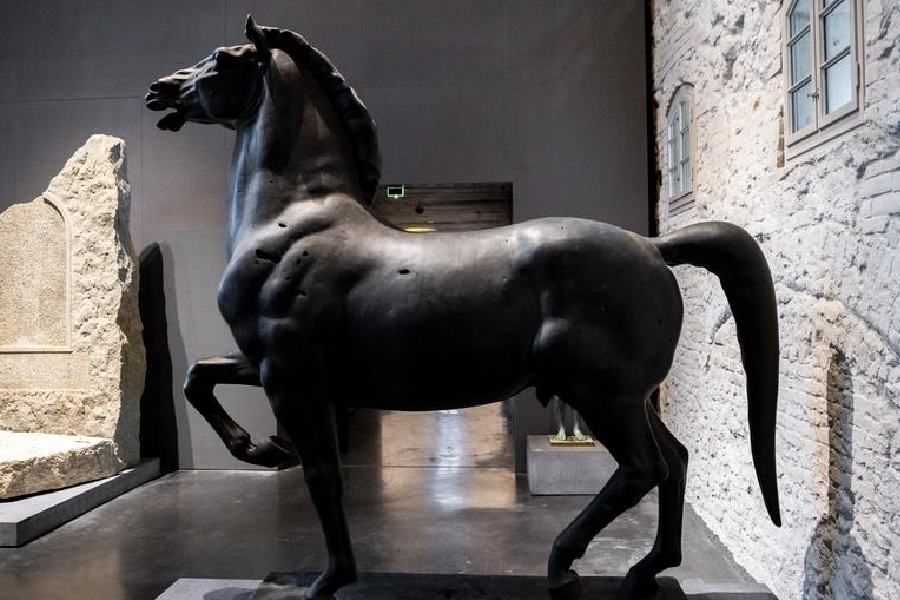Nazi artist Josef Thorak created the two "Striding Horses" (known in German as "Schreitende Pferde") for Adolf Hitler's New Reich Chancellery in Berlin.
Now the sculptures will be shown again for the first time in the Spandau Citadel. One of the horses has been on display there for some time, and the second one is now being unveiled and examined by restorers.
On the Day of the Open Monument on September 10, 2023, it will be permanently presented again for the first time, according to the museum, along with other problematic works of art.
Commissioned by Hitler at the height of his power, the colossal twin "Striding Horses" had stood in the garden of Hitler's seat of government from 1939 to 1943. They were part of the thousands of bronze works crafted for the Nazi regime in its quest to transform Berlin into the imperial global capital of "Germania."
Who was Josef Thorak?
Josef Thorak was born in Vienna on February 7, 1889 and attended the Vienna Art Academy, eventually moving on to the Berlin Art Academy in 1915. After his studies he established himself as a sculptor of monumental works such as the 4-meter-high (13-foot) gable figure for the Reichsbank building in the western German city of Buer.
His style secured him numerous government commissions, and he became known internationally when he worked on, among others, the Security Monument in Ankara, Turkey, in 1934.
From 1937 onward, Thorak became one of the preferred sculptors of the Nazis, commissioned to create countless propaganda sculptures emphasizing the supposed strength and glory of the regime.
While Hitler and his regime persecuted Jewish and modern artists who they claimed produced "degenerate art" and looted the collections of Jewish art collectors, Thorak flourished. He divorced his Jewish wife and accepted a prestigious position at the Munich Academy of Fine Arts. After the end of World War II, he continued to create unchallenged until his death in 1952.
Why display Nazi sculptures?
The "Striding Horses" were only rediscovered in 2015 after a spectacular raid on an underground art trading ring operating in Germany. Police secured the horse statues, as well as sculptures by Fritz Klimsch and Arno Breker, two more of Hitler's favorite artists.
The works were probably intended to be sold on the black market, because Nazi art remains taboo on the official market, as art historian Christian Fuhrmeister told DW in 2015. "There are some private collectors in Germany, in the US or in Russia, there are people who are enthusiastic about it," he said.
According to the official website of the Spandau Citadel, a former Renaissance fortress turned exhibition space, the purpose of displaying the sculptures is to illuminate how "the respective state powers wanted to shape the Berlin cityscape" through the monuments they commissioned. The collection features monuments created from 1849 to 1986, covering the German Reich, the Weimar Republic, Nazi Germany and East Germany.
Nazi sculptures in German public spaces
Stating on its website that the sculptures are "testimonies to German history," the museum has deemed the featured monuments "important symbols" of German history. The adjective "important" may raise some eyebrows, but the museum explains it is aiming to transform itself into a center for the study of "toxic" monuments. The federal government has also supported the acquisition of the "Striding Horses."
Previously, the display of Nazi art has led to fierce protest. Last year, the Pinakothek in Munich was slammed in an open letter for displaying a painting by Adolf Ziegler, another Nazi artist. Georg Baselitz, one of the world's most influential living artists, called for it to be removed.
"It is shocking that Nazi propaganda is possible in this grubby way in a Munich museum," Baselitz wrote last October. He added that it was "unbearable" that works by artists who were persecuted by the Nazis hung next to the work of an artist responsible for their persecution.
In fact, plenty of Nazi propaganda sculptures remain in public spaces, such as in Berlin's Olympic Stadium, commissioned by the Nazi regime for the 1936 Olympics. Ahead of the World Cup in 2006, for which the stadium was one of the venues, some activists called for the removal of its statues. However, the city refused on the grounds that a removal would be a denial of Germany's history.











